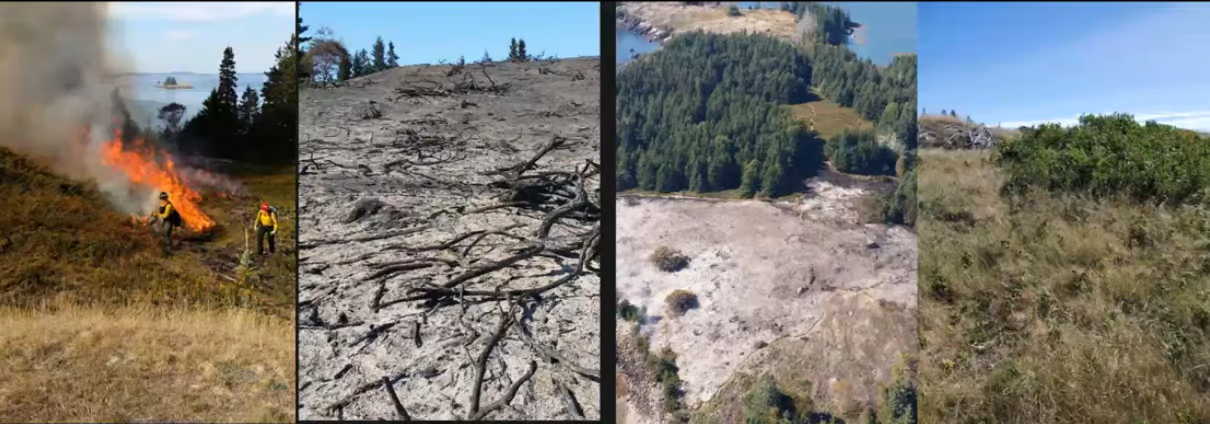It’s nearly impossible to walk around Bar Harbor without being reminded of the fire of 1947. The vegetation has regrown, but relics remain scattered in the understory all over town — foundation stones, crumbled chimneys, the odd statute.
The first house we lived in here had been assembled on the ruins of one that had been consumed by flames; while digging holes to set fenceposts, we hit a layer of ash in the soil.
The fire changed the island. Hundreds of homes and majestic summer estates were destroyed and never rebuilt, spurring a shift for the town from a playground for the wealthy to the tourist magnet it is today.
It also changed the vegetation, clearing away old growth and patches of spruce and fir and opening areas for sun-loving, short-lived deciduous trees like birch and aspen. It made the forest more diverse, both in age and composition, and “even enhanced the scenery,” as one history by the National Parks Service put it.
“Today, instead of one uniform evergreen forest, we are treated to a brilliant mix of red, yellow, and orange supplied by the new diverse deciduous forests.”
While overall a fairly wet state, Maine has seen an increasing number of wildfires in recent years, as droughts intensify, development increases and more and more people venture into the woods. (Almost all wildfires in Maine — 92% — are started by humans. Make sure those campfires are out!)
The wildfire risk in Maine is projected to increase “significantly” in coming years, according to the Maine Forest Service, as temperatures rise, droughts increase, and summer soil moisture drops.
One of the ways to reduce this risk is by fighting fire with fire. Humans have been intentionally setting things ablaze for thousands of years, often as a way to clear the undergrowth so it doesn’t unexpectedly go up in flames.
Fire has also long been used as an agricultural tool to encourage new growth (the diehards still use it as a way to clear blueberry fields downeast). In New England, however, the custom has mostly fallen by the wayside, as fertilizers and mechanized farming equipment came into the picture and homes, power lines and other infrastructure spread across the landscape.
But some land managers in Maine are once again turning to fire as a tool to manage their forests, looking to controlled burns to prevent wildfires, manage invasive species and restore habitat.
“These trees need fire to keep them healthy,” said Jon Bailey, who manages preserves for The Nature Conservancy, during a discussion last week on how to use fire to manage forests in Maine.
There may be spring burns to get rid of grasses, or burns during the growing season to kill invasive shrubs that are competing with native species. Landowners may set controlled fires to support public access or reduce the risk of wildfire in densely populated areas.
“We burn at all different times of the year,” explained Aliesha Black, a forest ranger for the The Maine Forest Service. “It all depends on what the goal is for that burn.”
Fire is “a huge part” of forestry management elsewhere in the country, and a useful one, said Logan Johnson, executive director of Maine TREE, a nonprofit that advocates for the sustainable use of Maine’s forests.
But it’s complicated to use for forestry management in Maine — even with a permit, landowners are liable for any fire that escapes and damages nearby properties or injuries that occur as a result of a burn, said Johnson.
“Each state has a different whole process on what the liabilities are,” said Jon Bailey, of The Nature Conservancy, which operates worldwide. “The southeastern states — Florida and Georgia — you’re more protected in burning, because there’s more of a culture of burning.”
There are only a handful of contractors in the northeast who have the proper insurance for prescribed burns, said Bailey, and getting coverage is typically prohibitive expensive for private landowners or land trusts. “That is one of the biggest challenges, is finding insurance companies willing to insure them.”
While insurance challenges remain, Johnson said he expects fire to become a bigger part of the forestry management in Maine.
“It’s not part of our culture as much, but it’s becoming more so.”







